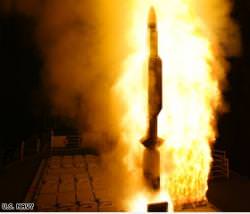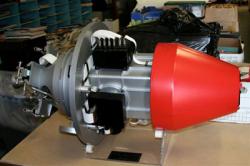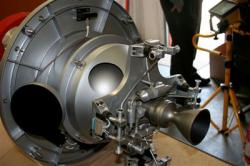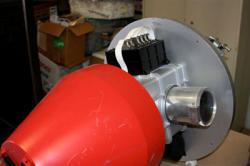In February, the Universe Today followed the sad tale about a dead US satellite called US-193, lifelessly floating around in orbit, possibly threatening the world by dumping hazardous fuel onto a city somewhere. This was the perfect time for the US Navy to launch their Standard Missile-3 (SM-3) into space, smashing US-193 to tiny bits. It worked and it worked well.
Although we’ve seen loads of pictures of the rocket being launched, and the pinpoint accuracy it accomplished by detonating in low Earth orbit, but what technology goes into the actual warhead that takes out the satellite? Well, in an article just published, images of an older generation “Kinetic Energy” anti-satellite weapon are on display. And to be honest, it doesn’t look that scary…
There’s more than one way to kill a satellite. You can make it self destruct by firing its thrusters, sending it in a deadly descent through the atmosphere. But say if you don’t have communication with the craft? You could capture it in orbit using a robotic or manned spaceship. But this would be prohibitively expensive and dangerous. You could simply shoot it down… now this idea (although far from being “simple”) is the most popular and effective method to get rid of a satellite from orbit.
The anti-satellite (ASAT) idea has been around since the Cold War, as far back as the 1960’s, but very little information is available. In fact, according to Dwayne Day’s article in The Space Review on the 31st March, since the Cold War nobody has been bothered to write much about American ASAT technology development, policy, and doctrine. It is unclear if this is down to the military being (understandably) secretive, or whether people simply lost interest in the “Star Wars” program proposed by U.S. President Ronald Reagan in 1983.
But there are some clues as to the US anti-satellite capabilities back in the 1990’s, namely a cool-looking mock-up of one of Lockheed’s proposals for a kinetic energy anti-satellite warhead (or KE-ASAT, pictured left), the author discovered at the Aerospace Legacy Foundation’s offices located at the former North American Aviation Downey factory. The owner, a Dr. Jim Busby showed off a low fidelity mock-up of a Lockheed KE-ASAT, which he acquired in the early 1990s, when a previous owner discarded it.
It’s a strange-looking device, resembling a mini-spaceship capsule (although, from the images and description, it is unclear how big it is) that would have sat on top of a rocket booster to send it from the ground and into space to hit its satellite target. This type of anti-satellite does not explode on impact; it relies on huge velocities and a high mass to generate enough kinetic energy to destroy the target on impact.
Some variations on this theme may have included a Kevlar “fly swatter” that would expand on impact, making it easier to hit the satellite and destroy it.
It is obvious from the images that the mass of the warhead is packed in the red cone at the front of the weapon; the infrared heat-seeker targeting system would also be housed there. There is also a main thruster (that would fire to life once the rocket boosters had carried it into space), and attitude controls at the rear to guide the high velocity projectile to its target. A similar method was used by the February 20th US spy satellite intercept, so the proposed technology this KE-ASAT is built on is not far from the current method employed by the US Navy.
Alas, the KE-ASAT never made it to the production line as Lockheed’s bid for use in an anti-satellite program was beaten by the Rockwell company in July 1990, the US Army opted for a far different-looking design, not dissimilar to the ASAT used today. Personally I think the Lockheed concept looked better, but would have been very scary, causing a huge mess…
Source: The Space Review





Somehow I though it would look a lot more complex.
It look like some kind of plumbing device.
Thank you Ian for another interesting story.
The bits and pieces of the satellite as well as the warhead could be strewn across the space; posing more danger to other satellites. This definitely a war technology and not the most elegant civilian way to end a satellite’s life.
You don’t have to blast it to bits. You could simply fly up there with your remote controlled robot and spraypaint its cameras! Or you could shoot lasers into its cameras, burning them out.
Or you could wrap some wire around its solar panels, shorting them out.
Or you could use tools to cut into it or cut cables or fuel lines, whatever is exposed.
Or you could zap it with microwaves, frying the electronics inside.
I’m sure the military has thought of every one of these ideas and I bet every one of them is included in the current technology, which of course would be classified.
Essel, what do you suggest to kill a satellite? Either way it would send stuff flying across space.
That’s pretty much what they are. I used to work as a contract manager on ASAT Programs.
There is going to be big business in cleaning up space debriss.
About 13 years ago, I came across an interesting ASAT concept on the Raytheon website. Raytheon included a surprising amount of information for what should have been a rather secretive program, including a lovely artist’s conception. The page has long since been removed, but there is an infinitesimal chance that I still have a printout of it stuffed away somewhere.
In any event, the design was for a small satellite with a long “fly swatter” or “tennis racquet” arm. A fleet of such vehicles would have been parked in various orbits, from which they could be called upon as needed.
More information on such weapons can be found at the below link:
http://www.globalsecurity.org/space/systems/ke_asat.htm
*** Please note that details of this account may vary slightly from reality due to more than a decade of bit rot ***
“Essel, what do you suggest to kill a satellite? Either way it would send stuff flying across space.”
You grab it and burn a retro rocket. Or you pack it into a reentry cone if you want to keep the technology. But honestly how much space junk will remain in orbit for long? Most of it is too small or to slow (after the collision half of the material is probably knocked out of orbit promptly) to stay around. The biggest concerns are many sats. that are just left around in high orbits.
Hi All,
I find the idea of “shooting a satellite down” to be a little more than naieve. It can’t be done. Satellites are in orbit because of their large velocity. The only way to truely de-orbit them is to slow them down. Breaking them to pieces mearly makes a lot of little useless satellites that need to be tracked. Objects in the lower part of LEO will spiral back to Earth in a relatively ‘short’ time naturally because of atmospheric drag, but objects higher up will remain in orbit for a very long time (decades to thousands of years) whether they are large or tiny. The large ones are easy to track and avoid, but the smaller ones cannot be easily tracked and there are already far too many of them in orbit. They are a hazard to all space navigation and eventually one or more space missions WILL be seriously compromised by space junk unless we can clean it up. I would like to see an international ban on breaking spacecraft up in orbit by any method and it should have serious consequences for any state, company, or individual that ignores the ban for any reason. ASAT systems that leave many small pieces in orbit are hazards to all future space missions and have no place in a serious space fairing nation’s arsenal because in the long run they are as dangerous to the perpetrator as they are to all other spacefairers. Breaking satellites up in orbit is totally irresponsible. As one responder mentioned above there are other ways to neutralize space weapons and surveillance equipment if necessary. At least keep them in one big piece so they can be tracked.
Ron
The US has much more sophisticated means of eliminating orbiting objects.
They simply decided not to use them because they are *secret*, so they used 20 year old technology disguised as new technology.
Using a super-secret-laser to take out your own broken satellite wouldn’t be very smart. Enemies would realize that you have an advantage, and will quickly try to find out what it is. It’s best to save that special play for the game really counts. They know that China, Russia, North Korea already knows about American ASATs, to there was nothing to lose.
“And to be honest, it doesn’t look that scary…”
It’d look a whole lot scarier if it was coming towards you at ~10 km.s^-1…
Hey, no need for explosion with a delta-V of like Mach 15 or so at a 90% angle. A chunk of our miitary’s favorite heavy stuff, U-238, will do nicely. These mockups are more complex than I had imagine – but of course, you will be making course correction to insure impact!
Piece will go everywhere but the majority should deorbit after hitting that heavy piece of hallo!
You guys arn’t that smart……just f;y up there, and chain it to your ship…..then fly back.
Another satellite equipped with thrusters and gyroscope specialized in changing altitude and orbit to catch the suspect satellite and deliver a lode from a double barrel shot gun. like the gunfight at ok corral if the other satellite is also equipped as such.